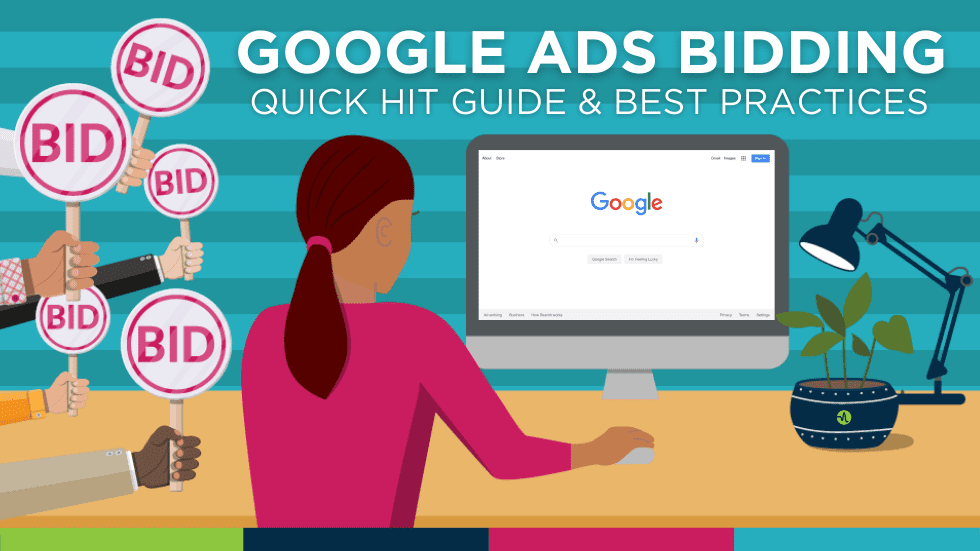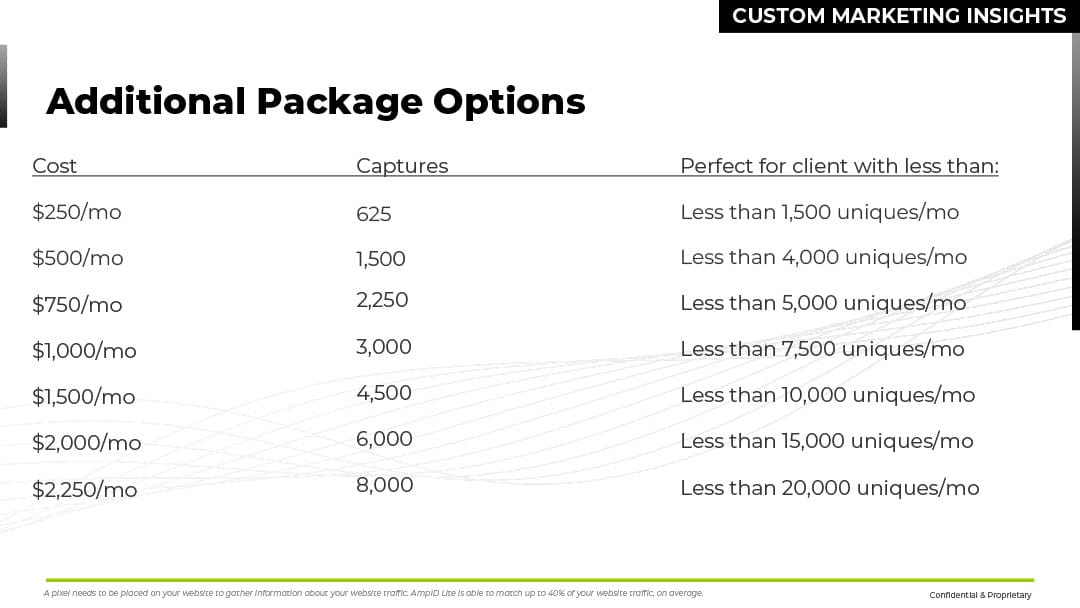Understanding the different bid types and implementing the right Google Ads bidding strategy for your goals can mean the difference between getting results and wasting your budget. In this post we will cover the basics of each strategy and hear from a couple of our Amplified Digital experts on best practices.
Quick Hit Guide
There are currently 11 different bid strategies to choose from on Google Ads. Our Quick Hit Guide categorizes the strategies based on the goals they can achieve as well as covers whether the bid strategy is automated or manual, gives a brief definition of each, and shows where the ads can be placed. We have also linked to the Google Ads Support page that details each strategy.
For a more in-depth look at each bid strategy in easy-to-understand language, we love this Ultimate Guide from AdEspresso.
Goal: Website Visits
- Strategy: Automated
- Definition: Bid amount adjusts to get as many clicks as possible within set budget
- Placement Options: Search and Display Networks
- Strategy: Both manual and automated
- Definition: Bid amount is manually set by advertiser but the Google Ads algorithm adjusts it based on the likelihood of the resulting sale or conversion
- Placement Options: Search and Display Networks
- Strategy: Manual
- Definition: Advertiser sets bid amount for different ad groups, keywords, or placements
- Placement Options: Search and Display Networks
Goal: Brand Awareness
- Strategy: Automated
- Definition: Advertiser pays per 1,000 views/impressions that occur
- Placement Options: Display Network and YouTube Ads
- Strategy: Manual
- Definition: Advertiser sets the maximum amount they are willing to pay to get their ad viewed
- Placement Options: Display Network and YouTube Ads
- Strategy: Automated
- Definition: Bid amounts adjust to achieve the set percentage of impressions and the placement on the page
- Placement Option: Search Network
- Strategy: Manual
- Definition: Advertiser sets the highest amount they are willing to pay for a video interaction
- Placement Option: YouTube Ads
Goal: User Actions
- Strategy: Automated
- Definition: Bid is adjusted to get as many acquisitions/conversions at the set cost
- Placement Options: Display and Search Networks
- Strategy: Automated
- Definition: Bid amounts adjust in order to get the most conversions within the set daily budget
- Placement Options: Search Network, Display Networks, and YouTube Ads
- Strategy: Automated
- Definition: Bids are optimized for each auction maximizing the set ad spend
- Placement Options: Search and Display Networks
- Strategy: Automated
- Definition: Bids adjusted to maximize the value of each potential conversion based on the ideal amount advertiser wants to earn from each ad dollar spent
- Placement Options: Search and Display Networks
We get it – the above is a lot to digest, so we asked a couple of our talented teammates for their take on Google Ad bidding strategies and best practices. Here’s what Caity Hepler, Senior Success Strategist & Trainer, and Joe Kerkhoven, Media Fulfillment Team Lead & Trainer had to say:
How do we determine which strategy to use?
“The main influence on strategy is our client’s goals. Other factors we consider are their spend, whether or not they are tracking conversions, and whether or not their average cost per click (CPC) is at, below, or well above industry benchmarks.
We usually start each campaign with a Maximize Clicks strategy. This allows us to gather data on how users will interact with each unique campaign. We tend to give it about 3 months before switching to something more conversion-focused like Target CPA or Maximize Conversions.
It helps to allow Google time to gather data before implementing conversion-focused strategies so it has data on the users that have already performed these actions.” – Caity
Our Top Picks
While every campaign is unique and can require a different strategy, we do have our favorites. Here’s a list of our go-to strategies and why according to Caity and Joe:
- Maximize Clicks: Drives website traffic from a group of highly relevant users that were actively searching for the particular products/services offered by our clients. Also gives us insight into the users who are engaging with a campaign at a baseline level.
- Target Cost-Per-Acquisition: Effectively drives leads while allowing us to easily control costs.
- Maximize Conversions: Increases valuable actions that occur on a website after a user clicks however it does remove the option to set a max bid so we usually see an increase in cost per click when this is implemented.
- Target Impression Share: Great option for driving visibility & brand awareness. It allows our advertisers to serve more impressions, regardless if the user clicks or converts.
“These strategies are the most common ones we use. Typically we will start with a Manual CPC or Maximize Clicks until we get enough data in the account. From there, we may experiment with a fully automated bid strategy (especially if they are tracking conversions) and will typically test out Maximize Conversions or Target CPA first.” – Joe
Which is better, manual or automated bidding?
“It depends! Google’s algorithm gets better and better every day and at this point is typically very good at what it does. It has access to data and insights in the competitive environment that we do not have, so a lot of times it may be better to automate the bidding.
On the other hand, automated strategies give us little to no control over our bids so if we wish to maintain complete control over the bid amount, we will use a manual strategy. This is what testing is for, as the best bid strategy will be apparent once we have enough data behind it.” – Joe
How frequently do we check in on campaign performance?
“This depends on the client’s spend and needs. Typically a Campaign Manager will check an account once a week at a minimum (sometimes more for minimum spend, simple campaigns), but will more than likely check in a few times per week or every day, again, depending on spend, need, complexity, etc.” – Joe
“Client Success performs a minimum of two quality assurance checks a month plus our monthly reporting touchpoint, so at least 3x a month just from our team. When we do our checks, we’re looking for major fluctuations in performance and ensuring results are staying consistent or increasing. We then work with the Campaign Managers to troubleshoot and problem-solve where necessary.” – Caity
When planning your own Google Ads campaigns it’s important to consider the time you will need to invest not only checking on campaign performance but also testing out different bid strategies.
How often does switching strategies make sense?
“We typically don’t want to make these changes too often as it’ll be difficult to draw conclusions on how the change truly affected performance. We won’t make any major changes once the campaign is launched until we have enough data to act on. Typically this is 2-3 months depending on spend and average cost per click (CPC).
From there, we will test one major thing at a time (like bid strategies) once a month or so, meaning we may only test a new bid strategy every few months or longer, but really, it all depends.
If the campaign has been running for a while and we’ve already tested a lot of things, we will likely be making changes less often. Especially if client goals remain the same and performance is strong, we will keep the bid strategy for a longer period of time.” – Joe
Let the Data Speak For Itself
“Bid strategies are always going to be based on our client’s objectives which can change over time. For the most part, paid search is used as a conversion/lead generator, which is why Target CPA has become a new personal favorite.
That being said, one bid strategy doesn’t fit all, so it’s important for us to remain flexible and try new things if our campaign isn’t yielding the metrics we had hoped for. At Amplified Digital, we’re big fans of letting the data speak for itself, we’re always willing to try something new, monitor performance, and pivot accordingly based on what the data tells us.” – Caity
The world of Google Ads bidding can be a scary, confusing place. Let our team of experts at Amplified Digital, with their in-depth knowledge, do the heavy lifting for you. Click here to get started today!



